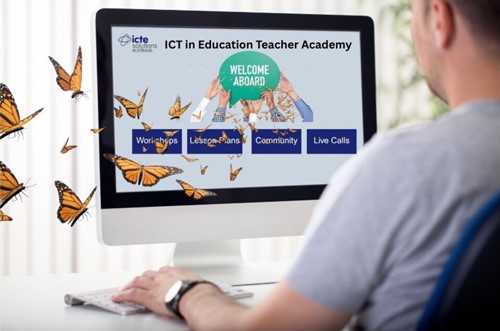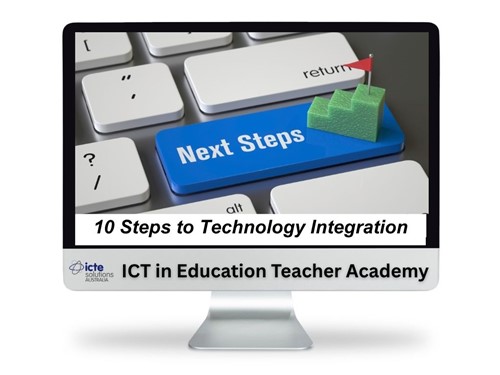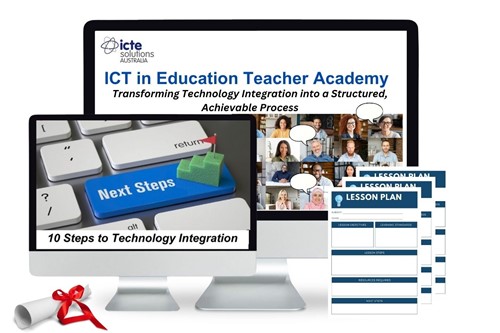By Michael Hilkemeijer

Beyond Strategies: How one teacher Transformed Technology Integration with 10 key membership steps
What does successful integration of technology in the classroom actually look like in practice?
Introduction: Why general strategies only go so far
You’ve probably read the lists—structure your tasks, choose tools wisely, align with learning goals. These are great starting points, but what happens when you’re ready to go further?
If you’ve ever found yourself asking “What does real progress look like when integrating technology in education?”, this story is for you.
Let’s walk through the 10-step transformation journey that educators inside the ICT in Education Teacher Academy take. Unlike a one-time workshop, this membership equips you with a professional learning roadmap, community feedback, ready-to-use resources, and a toolkit to apply best practices for integrating technology in the classroom—all in one place.
10 strategies the membership uses to support technology integration in the classroom
Below is a list of the membership’s internal strategies that guide real educator transformation:
| STEP | STRATEGY | PURPOSE |
|---|---|---|
| 1 | Self-Assess Your Starting Point | Know your current level of ICT integration confidence and capability. |
| 2 | Follow a Structured Success Path | Use a clear Adoption → Adaptation → Infusion → Transformation model. |
| 3 | Map Your Learning with the Workbook | Set personal goals and connect ICT strategies to your teaching. |
| 4 | Use Done-for-You Lesson Plans | Start applying technology with confidence using editable, pre-made activities. |
| 5 | Track TPACK Growth Visually | Use the workbook’s radar chart to see your development across TK, TPK, and TCK. |
| 6 | Apply Feedback from the Community | Share your lesson plans and get input from peers who’ve been there. |
| 7 | Integrate Observation & Assessment Tools | Use templates to observe student use of ICT and gather evidence for APST. |
| 8 | Reflect Using Prompted Reflection Tools | Move beyond surface reflection with structured workbook questions. |
| 9 | Share and Adapt with Member Collaboration | Access the Members’ Library and see how others modify lesson plans. |
| 10 | Revisit and Scale Up | Use scaling guides to adapt one lesson over time and across age groups. |
Each of these strategies aligns with best practices for integrating technology in the classroom, but the magic lies in how they build on each other.

Meet Amelia: A case study in successful integration of technology in the classroom
Amelia is a foundation teacher at a public primary school. She had access to a laptop trolley and a few Bee Bots—but never quite felt confident weaving technology into her weekly lessons. It always felt like an “extra,” not a natural part of learning.
When Amelia joined the membership, she began with Step 1: Self-Assessment. She quickly realized she was operating at the Adoption stage—using tech occasionally but without deep student engagement.
From there, her journey unfolded:
-
In Step 2, she chose to focus on the Numeracy stream in the Success Path and selected a Shape lesson plan using Bee Bots.
-
She used the lesson planning template from the workbook in Step 3 to adapt it to her Year 1 class.
-
With Step 4, she downloaded the “Roll a Shape and Trace It” plan and conducted her first tech-enhanced maths rotation.
-
Using the TPACK radar chart in Step 5, she tracked her growth in Technological Knowledge.
-
At Step 6, she posted her reflections in the membership community, receiving feedback about grouping strategies and extension questions.
-
With Step 7, she used the observation table to assess how students applied directional language and digital drawing tools.
-
In Step 8, the reflection prompts helped her articulate not just what worked—but why it worked.
-
By Step 9, she had shared her variation of the lesson with the community, adapting it for outdoor chalk mazes.
-
In Step 10, she used the “Scaling Your Lesson Plan” guide to move the same activity toward Infusion, integrating it across numeracy, art, and digital technology over three weeks.
Today, Amelia doesn’t just use technology—she integrates it. She feels empowered, her students are engaged, and her lessons are now purposeful and future-focused.
The Real Question isn't “can you integrate technology?” — it’s “Are YOU supported to?”
The integration of technology in the classroom doesn’t happen by accident. It requires structure, support, and time—exactly what this membership is built to offer.
This isn’t just professional development for technology integration in the classroom—it’s a transformation framework. A membership that supports your growth step by step, resource by resource, lesson by lesson.
So if you’ve ever downloaded a tech lesson from Pinterest and wondered what to do next—now you know where to go.
Ready to go beyond the strategy list?
Join the ICT in Education Teacher Academy and start following the 10 strategies that move you from intention to action.
🟢 You’ll get structured tools.
🟢 You’ll grow professionally.
🟢 You’ll actually see technology working in your classroom.
What every teacher should know about managing technology in their classroom?
From device rules to digital routines—here are 10 practical points every educator should master.
Managing technology is more than keeping kids on task
You asked how to manage technology in the classroom.
You’ve got the devices.
You’ve got the lesson ideas.
But how do you create a learning environment where technology supports focus, collaboration, and responsibility?
That’s exactly what we answer in detail on our full blog:
👉 Classroom Management Strategies for Laptops
But if you're short on time and need the highlights, here are 10 key strategies that will change the way you think about managing technology in any learning space—whether you’re teaching preschoolers, Year 3s, or somewhere in between.
10 strategies to help you confidently manage technology in the classroom
| STEP | STRATEGY | WHY IT WORKS |
|---|---|---|
| 1 | Establish Digital Expectations Early | Children respond to structure—define what responsible tech use looks like from day one. |
| 2 | Create a Visual Tech Agreement With Students | Co-create class rules about technology use so expectations are shared and respected. |
| 3 | Designate Clear Tech Zones and Access Times | Helps children associate tools with purpose, not distraction. |
| 4 | Model, Don’t Just Tell | Demonstrate how to open apps, handle devices, and ask for tech help. |
| 5 | Use Visual Timers for Tech Tasks | Keeps young learners on track without needing constant redirection. |
| 6 | Teach 'Tech Talk' Language Prompts | Phrases like "I need help with…" or "Can I swap with you after?" promote collaboration and reduce interruptions. |
| 7 | Assign Tech Monitors or Helpers | Empowers students to take responsibility for devices and routines. |
| 8 | Integrate Screen-Free Transitions | Support self-regulation with clear off-tech activities (stretching, journaling, pairing). |
| 9 | Reflect with the Class on Digital Use | Use end-of-day check-ins or journaling to build digital citizenship. |
| 10 | Have a Plan for Glitches and Tech Failures | A predictable Plan B keeps learning smooth when tech doesn’t cooperate. |
Each of these is unpacked in our full blog
These 10 points are just the beginning.
In our full article, Classroom Management Strategies for Laptops, you'll get:
-
Real examples from early years and primary classrooms
-
Tips for adapting strategies for tablets, laptops, or Bee Bots
-
Workbook-based planning suggestions for members of the ICT in Education Teacher Academy
-
A mindset shift: from “managing devices” to supporting digital responsibility
If you’re serious about making technology work for your classroom, not against it—this blog is essential reading.
Ready to rethink how technology is managed?
Click below to read the full blog and find classroom-tested strategies that fit your context:
👉 Read: Classroom Management Strategies for Laptops
Or explore how our members plan, manage, and scale tech use using step-by-step tools inside the ICT in Education Teacher Academy.
You’ll learn that managing technology in the classroom isn’t about control—it’s about building digital fluency, independence, and engagement from the ground up.

10 Strategies to Start Today
As a primary teacher, your aim should be to develop student ICT capability when integrating technology in the classroom. This is best achieved when the technology remains transparent in its use and this is when the students hardly notice that they are using technology to achieve learning outcomes.
This is the key to successfully integrating technology in the classroom.
It is significant to remember that it is the way that the technology in the classroom is employed, not the technology itself that makes the impact on student learning. You will find many strategies for integrating technology in the classroom in our 60 + online technology integration professional development courses (Academy).
To help you get started, here are 8 of the best strategies for integrating technology in the classroom today.
Start with classroom organisation
The way in which a classroom is organised can make a difference to the potential of ICT capability development. It is important, therefore, that the computers are placed in a classroom so as to maximise the opportunities for curriculum activity.
Additionally, if the activities are well planned then good ICT work can be achieved with even one or two computers. Effective technology integration in the classroom can be achieved with just one or two technological devices. Clear planning also concerns the age-group or the curriculum activity for which the technology is best suited.
It will also be important that establish your classroom rules and procedures when using technology in the classroom. Students should be clear about the expected behaviour and how to handle any arising technological issues. An idea would be to number each device and allow students to have a sense of ownership.
Group students and resources appropriately
Successful schools in the past have given careful thought to the strategies for integrating technology in the classroom. Grouping students and resources for ICT activities were influenced by their decisions.
The pairing of students needs to take into account various factors such as the differences in ICT capability, the personalities of the children, sex, and the nature of the task.
It will be difficult to give adequate attention to groups working on different activities so if you have adult assistance it would be imperative to brief them and to use the following strategies for integrating technology in the classroom:
- Invite the children to plan ahead;
- Ask them to listen to what the children say and encourage them to share their ideas;
- Provide assistance and help to children so that they understand that it is acceptable to try their ideas and to make mistakes;
- They need to give the students time to work out their answers;
- Make the most of every opportunity to give praise to the students’ success when they have completed an exercise or developing a computer skill.
Take into account students’ ICT capability when planning
To achieve this, you can plan a mini-lesson that will have an ICT activity that will demonstrate the expected level of capabilities of the students. From here, you can plan for the progression and continuity of their ICT capability.
Teaching a mini-lesson prior to the actual lesson itself is the key as the students won’t be distracted and are likely to fully participate. This is because they will know that paying attention and demonstrating their understanding of rules, procedures and tasks means that they will get to use the technology again.
Become familiar with the ICT resource
It is more important for you to be knowledgeable about one program than it is to be acquainted with many. This is because it is better for students to work with a small number of versatile programs and progressively develop skills and confidence in these through carefully structured activities than it is to learn how to use a large number of programs superficially.
However, being familiar involves more than just knowing how to use the program for a variety of tasks. It is about reflecting on the processes it helps the student to carry out and the ICT techniques with which particular effects can be achieved. It then also requires you to consider how the students will be introduced to the program, what ideas need to be clear before they start and where they might find difficulties.
Make digital citizenship a priority
When students are ready to use technology in the classroom to achieve the learning outcomes set by you as the teacher, it is your chance to develop their ICT capability. This comprises of 21st century capabilities such as routines, ICT techniques, concepts, higher-order thinking skills, and processes. To learn more about achieving this, you will find this online workshop in my Academy.
Monitor progress and intervene to help students
The most effective teaching when integrating technology in the classroom occurs when you have well-planned interventions and are capable of responding to ad hoc opportunities that arise to stimulate learning at important moments. Timely interventions in the past have been proven to be beneficial in developing students’ technical skills and knowledge of ICT in addition to developing their higher-order thinking skills.
Monitoring is also important as it is common for students to appear to be usefully occupied with the task when they are in fact working very inefficiently and failing to exploit the potential of the technology in the classroom. Also, because of the richness of the ICT resource, students may divert from the intended tasks without it being obvious from their behaviour.
In this online course for teachers, I discuss how you can monitor the key characteristics of ICT capability such as those mentioned earlier. Again, you can join this course when you become a member of the Academy today.
Use the power of choice
Integrating technology in the classroom is an instructional choice that generally includes collaboration and deliberate planning. Thoughtfully planned it can engage students in lessons and lead to developing 21st century capabilities. This is only the case if you provide opportunities for each student to make choices over their own learning. By this, strategies for integrating technology in the classroom have a lot to do with providing choices for practice, creativity and discovery.
Successful teachers have employed such strategies for integrating technology in the classroom which has led to the progression of ICT capability. They don’t just teach more and more ICT techniques for their own sake but provide tasks that require sensitivity to information requirements, sophisticated decision-making, knowledge of available tools, and accuracy in evaluation. It is best to teach ICT techniques at the stage where the task provided a subtle context.
Question the whole class
Past studies have indicated that successful teachers have questioned the whole class or group prior to ICT activities to clarify their expectations. This also helped in getting students to focus on what they going to do and also generated ideas about how they might go about it.
During this process, it was found that it was helpful for the students to identify the reasons why they needed to plan their work on paper first so that they had a clear view of the layout of a document or the structure of a database.
Structure tasks
Use structured tasks to introduce particular ICT techniques and ensure that students have the opportunity to use those ICT techniques subsequently in more open tasks in which students can make decisions about the choices of ICT techniques.
Understand that there is more than one learning purpose
It is important to understand that ICT activities typically have more than one learning purpose. If you plan to integrate technology into meaningful subject-related activities you will be able to combine the ICT and other subject issues into your discussion and questioning of the class or group.
You can learn more about successful strategies for integrating technology in the classroom by enrolling in one of my many online workshops for teachers today.


What does it look like to plan a lesson with technology—confidently and purposefully?
See how members move from idea to implementation using a 10-step planning framework.
When the lesson plan is the bridge, not the barrier
It’s easy to feel stuck when you're holding a great idea… and then asking yourself:
-
“How can I integrate technology into this lesson?”
-
“How do I match the tech to my learning goals?”
-
“What’s the best way to make sure it’s not just a ‘fun extra’?”
Inside the ICT in Education Teacher Academy, lesson plans are more than just activity ideas. They’re designed to take you step-by-step from a great idea to a well-integrated, curriculum-aligned, confidently executed learning experience.
This is where you move from just adding technology… to intentionally embedding it.
Let’s walk through the exact process.
The 10-step method to integrate technology with purpose
Every lesson plan in the membership comes with a structured framework that supports teachers in applying best practices for integrating technology in the classroom—even if they’re starting from scratch.
| STEP | WHAT YOU DO | MEMBERSHIP TOOL | HOW THIS SUPPORTS INTEGRATION |
|---|---|---|---|
| 1 | Choose a lesson that fits your curriculum goals | Access the Members' Library | All activities are curriculum-linked |
| 2 | Map the learning intention and outcome | Workbook: Planning Template (pg. 114) | Helps ensure technology enhances—not distracts from—the learning goal |
| 3 | Match ICT to the children’s ability level | ICT Levels of Differentiation | Provides tiered tech skills (basic, intermediate, advanced) to personalise learning |
| 4 | Set Learning Goals | Embedded in each lesson plan | Already linked to EYLF outcomes so you can copy straight into your program |
| 5 | Ask: How can I incorporate technology into this activity? | Workbook prompts for lesson alignment | Encourages intentional ICT use—not just “adding a device” |
| 6 | Decide how you’ll observe and assess learning | Higher Order Thinking Table (pg. 182) | Makes tech integration visible with structured skills-based observation |
| 7 | Adapt to your context | “Ideas for Adapting to My Context” in every plan | Whether you’re outdoors, tech-limited, or working 1:1, there’s a modification suggestion ready |
| 8 | Reflect after implementation | Critical Reflection Prompts in the Workbook | Questions guide you to adjust and scale tech use after the lesson |
| 9 | Share with peers and get feedback | Community Forum & Wisdom Tool | Get ideas, extensions, and solutions from other educators in real time |
| 10 | Scale up the lesson | Scaling Your Lesson Plan Guide | Move from first attempt (Adoption) to deeper tech use (Infusion) without needing a new lesson |
This planning method is more than a checklist—it’s your guide to continuous growth.
Meet Lena: A member story in real-time
Before joining the Academy, Lena had a set of Bee Bots sitting in a cupboard for six months. She’d seen them used in PD sessions but never felt sure how they connected to her class goals. "I kept wondering—how can I integrate technology into this lesson if I don’t even know where to start?"
Here’s how Lena used the membership’s 10 steps to move forward:
🟢 Step 1-2: She chose the “Drawing with Programmable Toys” lesson and mapped her learning intentions in the workbook. It linked to both numeracy and creativity.
🟢 Step 3: Using the ICT Levels of Differentiation, she realized most of her class could move the Bee Bot randomly, while two children were ready to program turns.
🟢 Step 4: The plan already listed clear EYLF goals, which she copied straight into her documentation.
🟢 Step 5: A workbook prompt asked: “How can I incorporate technology into this activity to give children control?” That inspired her to let children pick the marker colours attached to the Bee Bots.
🟢 Step 6-7: She used the Higher Order Thinking table to track logical reasoning and creativity, and adapted the activity to run outdoors using chalk paths.
🟢 Step 8-9: After the session, Lena reflected in her workbook and posted in the Community Forum: “How can I extend this into a digital storytelling activity?” A member suggested using a drawing app for retelling the Bee Bot’s “journey.”
🟢 Step 10: Lena then used the Scaling Your Lesson Plan guide to embed the concept across numeracy, literacy, and digital art over a 3-week period.
Today, Lena doesn’t ask “How can I integrate technology into this lesson?”—she’s now designing cross-curricular units using ICT with confidence.
When planning is Professional Development
Planning with the Academy tools isn’t just preparation—it’s professional development for technology integration in the classroom.
Every lesson plan includes:
-
APST-aligned reflection prompts
-
Tech integration at three ability levels
-
Structured feedback loops with peers
-
Built-in assessment tools and curriculum connections
-
Guidance for ethical, developmentally appropriate ICT use
This means every time you plan, you’re building your digital pedagogy and tracking your growth—not just prepping an activity.
Imagine what your planning could feel like in 3 weeks…
-
You download a lesson and know it’s already curriculum-aligned
-
You use the workbook to plan and reflect without starting from scratch
-
You confidently differentiate the tech tools based on skill levels
-
You walk away with clear observations, peer insights, and new ideas for extension
This is what technology integration in the classroom looks like—when it’s built into your routine, not added on as a burden.
You're one lesson away from starting the journey
Every time you ask “How can I incorporate technology into this activity?” or “How do I do this meaningfully, not just for the sake of it?”—the answer lives inside the membership.
🟢 Start with one lesson plan.
🟢 Follow the 10 steps.
🟢 See what happens next.
👇 Click below to get access to your first lesson and begin your planning journey.
Also in this series:
Read the first part of this blog—“Beyond Strategies: How One Teacher Transformed Technology Integration with 10 Key Membership Steps”—to see the full path from self-assessment to transformation.


What does effective Professional Development for Technology Integration really look like?
Most educators are searching for the next PD. Our members are transforming their classrooms instead.
Not another one-off session—Something deeper!
Emma didn’t sign up for another course.
She didn’t attend another after-hours workshop hoping it would “stick.”
She joined something that fit into her teaching—because it grew with her.
She’d searched for professional development for technology integration in the classroom after too many moments of frustration—when the ideas were there, but the application wasn’t.
What she found was not just PD.
It was a space to learn, apply, reflect, and evolve—as a teacher, not just as a tech user.
This is Emma’s story.
Emma’s Week 1: Choosing one lesson and finding clarity
Emma logged into the ICT in Education Teacher Academy with one goal:
"I just want to feel confident using technology in a purposeful way."
She opened the Members’ Library and found a lesson titled “Digital Nature Walk & Photography.”
What caught her attention?
A section in the lesson plan that read:
Best-suited workbook tools:
Planning Template (pg. 114), Observation Guide (pg. 101), Community Reflection Prompts (pg. 182)
She downloaded it and opened her workbook to page 114.
Within 30 minutes, Emma had:
-
Mapped out her EYLF-aligned learning intention
-
Identified how the digital photography experience met both science and literacy goals
-
Jotted down her own context notes (limited tablets, small group rotation)
-
Used the ICT Levels of Differentiation table to set different tech goals for each group
She wasn't just reading about ways to integrate technology in the classroom.
She was doing it—thoughtfully and with structure.
Emma’s Week 2: Applying, observing, and noticing something new
By the following week, Emma was in the school garden with five children and two tablets.
She watched as:
-
One child zoomed in to photograph leaf patterns
-
Another noticed symmetry in bark and captured it
-
A third recorded a voice message explaining the difference between two plants
Emma pulled out her printed Observation Guide (pg. 101).
She wasn’t guessing what to look for.
She was observing digital skills, inquiry learning, and communication—all aligned with EYLF and the Higher Order Thinking Skills Table.
After the session, she turned to pg. 182 and answered a prompt:
What surprised you about the children’s interaction with technology?
She wrote:
“They showed more intentionality than I expected—especially with framing and explaining their photos. The tech enhanced—not replaced—their connection to nature.”
Emma’s Week 3: going deeper, not wider
Instead of jumping to a new idea, Emma followed the Scaling Your Lesson Plan guide.
She returned to the classroom, uploaded the photos, and used Book Creator to help the children make digital nature journals. Each child narrated their learning with voice recordings.
Emma posted in the membership community:
“Has anyone extended this activity into storytelling or science journaling?”
By morning, she had 3 replies and a shared video of a similar adaptation using QuiverVision.
She chose to try it next week.
Emma’s Reflection: “This is the first time it’s felt embedded”
Three weeks.
One lesson.
And she had:
-
Implemented and adapted a tech-integrated lesson
-
Differentiated based on digital skill levels
-
Collected real-time observations for formative assessment
-
Reflected on pedagogical decisions using structured prompts
-
Shared and received peer ideas inside a supportive, focused community
No extra sessions.
No disconnected advice.
No gimmicks.
Just embedded, authentic, and supported professional development for technology integration in the classroom.
What makes this the place to learn best practices?
We don’t have to say it.
You just read it.
From choosing a lesson to scaling it across key learning areas—every part of the membership is designed to guide educators in learning by doing.
Here’s what’s quietly built into every lesson plan, workshop, and reflection prompt:
-
Clear EYLF outcomes and APST alignment
-
Differentiation tools that meet children where they are
-
Lesson templates that help you plan with purpose
-
Assessment tools that make learning visible
-
Reflection questions that build your confidence, not just your checklist
-
Peer stories and examples that keep you evolving, not overwhelmed
This is how members experience and apply the best practices for integrating technology in the classroom—not through a one-day event, but through repeatable, supported practice.
So if you're still asking, “What’s the best way to grow in tech integration?”
You already know the answer.
It’s not another article.
It’s not another PD flyer.
It’s a place where planning, reflection, and peer feedback are woven together every day.
📥 Click below to step into the membership and begin your own Emma-style journey.
Start with one lesson. Follow the workbook. Ask a question. Reflect. Grow.
You’re not just joining PD.
You’re joining a movement of teachers embedding real technology integration in early learning and primary classrooms.
